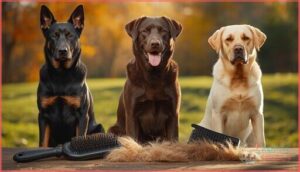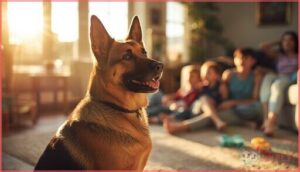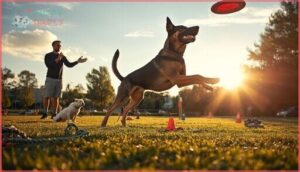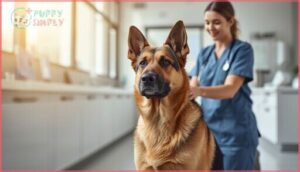This site is supported by our readers. We may earn a commission, at no cost to you, if you purchase through links.
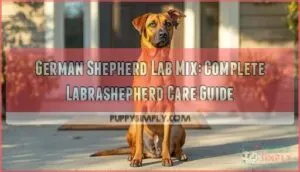 A German Shepherd Lab mix doesn’t walk through your front door quietly—it bounds in, tail wagging, nose twitching, ready for anything. Known as the Labrashepherd or Sheprador, this hybrid brings together the loyalty and brains of a shepherd with the sunny nature of a Lab.
A German Shepherd Lab mix doesn’t walk through your front door quietly—it bounds in, tail wagging, nose twitching, ready for anything. Known as the Labrashepherd or Sheprador, this hybrid brings together the loyalty and brains of a shepherd with the sunny nature of a Lab.
The blend isn’t accidental; families looking for a dog that’s enthusiastic to please and a versatile mix often seek out this breed. Understanding what makes German Shepherd Labrador mixes unique can be the difference between a good dog and a great companion—one that always keeps you guessing.
Table Of Contents
- Key Takeaways
- What is a German Shepherd Lab Mix?
- German Shepherd Lab Mix Appearance
- Personality and Temperament Traits
- Training and Exercise Requirements
- Common Health Issues in Labrashepherds
- Diet and Nutrition for Shepradors
- Top 5 Products for German Shepherd Lab Mixes
- Frequently Asked Questions (FAQs)
- What is the average lifespan of a German Sheprador?
- Are German Shepradors good with children and other pets?
- How do you find a reputable German Sheprador breeder?
- What types of foods and diet are ideal for a German Sheprador?
- Are Shepradors suitable for first-time dog owners?
- Can Labrashepherds adapt to apartment living?
- What activities do Shepradors enjoy most?
- How do Shepradors react to hot or cold weather?
- Conclusion
Key Takeaways
- German Shepherd Lab mixes are energetic, highly intelligent dogs that need daily exercise, mental stimulation, and early socialization to thrive as family companions.
- Their appearance and personality can vary widely, but you should expect moderate to heavy shedding, loyalty, protective instincts, and a strong desire to be involved in family life.
- This hybrid is prone to certain health issues like hip dysplasia, eye diseases, and bloat, so regular vet care and preventative measures are essential.
- High-quality food, durable chew toys, and consistent, positive training methods are key to keeping these active dogs healthy, happy, and well-behaved.
What is a German Shepherd Lab Mix?
If you’re considering bringing a German Shepherd Lab mix into your home, you’re probably curious about what makes this crossbreed tick. This hybrid—often called a Sheprador or Labrashepherd—combines two of America’s most beloved working breeds into one energetic package.
Let’s start by breaking down where this mix comes from, what to call it, and what each parent breed brings to the table.
Breed Origins and History
The German Shepherd Lab mix emerged during the designer dog movement, when early breeders intentionally crossed purebreds to combine desirable traits. Unlike ancient breeds with centuries of documented history, this hybrid developed relatively recently. Purpose-bred for intelligence and adaptability, these dogs reflect efforts to blend the Labrador’s friendly nature with the German Shepherd’s work ethic. These mixes are known for being an intelligent breed.
Key points about their origins:
- Hybrid Development began as breeders sought family-friendly working dogs
- Designer Dogs gained popularity in the 1990s and 2000s
- Breed Recognition remains unofficial—kennel clubs don’t register mixed breeds
- Early Breeders aimed to reduce health issues common in purebreds
Sheprador Vs. Labrashepherd Naming
You might see this mix called a Sheprador, a Labrashepherd, or even a Lab Shepherd mix—and honestly, they all mean the same dog. The name you hear most often depends on regional preferences and breeder marketing choices.
Since this hybrid dog isn’t officially recognized by major kennel clubs, there’s no standardized naming convention. Most owners simply pick whichever name rolls off the tongue easiest.
Parent Breed Overview
Thinking of a German Shepherd Lab mix means picturing the best traits from each parent breed. The Shepherd’s origins are in herding and police work, while Labs started out as water retrievers in Canada. Both soared in breed popularity.
This mixed breed can inherit:
- Intelligence from Shepherds
- Friendliness from Labradors
- Diverse working roles
- Lifespan averaging 10–12 years
They’re also known to be highly intelligent dogs and responsive to training.
German Shepherd Lab Mix Appearance
Regarding their appearance, German Shepherd Lab mixes are full of surprises. No two Shepradors turn out exactly the same.
Here’s what you can expect to notice most about their appearance.
Coat and Color Variations
Ever seen a Labrashepherd sporting a deep black dog coat with shepherd-like markings or a soft yellow reminiscent of Labs? Coat genetics really bring out the variety. While hypoallergenic coats aren’t in the cards, you’ll spot rare colors.
Shedding seasons mean hair everywhere, so investing in quality grooming tools is a must—regular dog grooming keeps those coat colors shining and keeps dog shedding manageable.
Size and Build
Picture a dog that lands somewhere between a stocky Labrador and a lean German Shepherd, often striking just the right balance in both size and muscle. Most German Shepherd Lab mix adults grow 22–26 inches tall, with a weight range of 60–85 pounds.
Their body proportions and physical features reflect both breeds, showing muscularity through every growth stage of this mixed breed.
Shedding and Grooming Needs
If you live with a German Shepherd Lab mix, you’ll quickly notice just how often their fur shows up on every surface—so regular grooming becomes your new best friend.
With those thick double Coat Types, expect moderate to heavy dog coat shedding, especially during seasonal changes. Brushing Frequency should be weekly (if not more), using Grooming Tools like a slicker brush or de-shedding rake for proper Coat care.
Bathing Needs? Monthly usually works.
Ear and Tail Characteristics
Ears and tails might seem like small details, but they really tell the story of your Sheprador’s heritage. You could see upright “satellite” ears (think classic German Shepherd), soft flops like a Labrador, or even something in between. And regarding tail length and tail carriage? Expect lots of variety! Breed standards don’t apply, but docking debate is rare here.
- Ear carriage: Anything from stand-up ears to floppy ones
- Tail length: Usually long, feathered, and strong
- Tail carriage: High and proud, or relaxed and waggy
Personality and Temperament Traits
Getting to know a Labrashepherd means understanding what makes them tick. Their personality and temperament shape everything from how they play to how they connect with your family.
Here’s what you can expect from this one-of-a-kind mix.
Energy Levels and Playfulness
There’s never a dull moment with a German Shepherd Lab mix—they’re like furry batteries that just keep going. Their high energy is best managed with daily exercise, lively playtime activities, and plenty of dog exercise and stimulation.
Without enough mental stimulation or movement, you’ll quickly notice restless behaviors or even some destructive behavior. Keeping them busy is key to a happy, balanced pup.
Intelligence and Trainability
Think your German Shepherd Lab mix is reading your mind? That’s their keen intelligence at work. These dogs grasp new commands fast, love problem-solving, and never forget good routines. Dog training feels more like teamwork, especially when you use positive reinforcement.
This mix shines with:
- Command comprehension
- Problem-solving skills
- Memory retention
- Adaptive learning woven into instinctive behavior
Protective and Family-Oriented Behavior
Ever notice how your Sheprador sticks to you like a shadow and keeps an eye on everyone at home? That’s the German Shepherd Lab mix personality shining through—guarding instincts shaken up with deep family bond.
A German Shepherd Lab mix is a loyal companion who shadows you everywhere, blending deep family devotion with protective instincts
High loyalty levels mean they make a family dog you can count on. Their separation tolerance is low, so they’re happiest close by, always ready to protect.
Socialization With Children and Pets
If your Sheprador is happiest when everyone’s together, you’ll be glad to know most of these pups thrive around kids and other pets when you set them up for success early on. Dog socialization and child safety go hand-in-hand with this German Shepherd Lab mix. Start by:
- Supervising play and introductions
- Watching for resource guarding
- Practicing temperament testing with early socializing
That’s true family pet suitability.
Owner Experiences (Sierra, Milo, Bentley, Buster, Buddy)
Nothing brings this mix to life quite like stories from real owners—so let’s hear what folks with Labrashepherds like Sierra, Milo, Bentley, Buster, and Buddy have to say about their day-to-day adventures.
Adoption stories range from joyful homecomings to overcoming early health challenges. Owners marvel at unique quirks, praise training successes, and celebrate family dog suitability, especially around kids.
Training and Exercise Requirements
Every Sheprador needs the right training and just enough activity to stay happy. Let’s look at key ways you can help your dog thrive at home and outside.
Here’s what you’ll want to focus on for a healthy, well-adjusted companion.
Positive Reinforcement and Clicker Training
Using treats and praise to shape your dog’s behavior can turn training into the best kind of game for both of you. With positive reinforcement and a clicker, you mark good choices the instant they happen—timing matters! Stick with effective rewards like tasty bits or gentle praise.
Consistency training, a steady tone, and basic obedience cues build trust and lasting results.
Socialization Strategies
Start with early exposure to different people and friendly pups—think puppy classes or casual meetups in calm spots. Practice leash manners on strolls through the neighborhood.
For breed-specific socialization, introduce your Sheprador to new situations slowly, using playdate etiquette and positive dog behavior cues to ease fear mitigation. Consistent dog socialization and training build real-world confidence.
Exercise and Mental Stimulation
Keeping your Labrashepherd active—both in body and mind—is the secret sauce to a happy, relaxed dog at home. Daily walks are a must, but add in Interactive Games, Agility Training, and Puzzle Toys to tap into their herding instincts and high energy.
Mixing mental stimulation with regular exercise meets your German Shepherd Lab mix’s true exercise requirements.
Handling Separation Anxiety
On those days when you need to step out and leave your buddy at home, it’s natural to worry about how they’ll cope with your absence. Early Intervention matters.
Crate Training offers comfort if introduced positively. Try Desensitization Techniques, like calmly picking up keys without leaving.
For severe dog separation anxiety, talk to your vet about Medication Options or seek Professional Help in dog behavior and dog training.
Common Health Issues in Labrashepherds
Even the healthiest Labrashepherds can run into a few common problems worth watching for. Knowing what’s ahead helps you stay one step ahead with care and prevention.
Here’s what you’ll want to look out for as a Labrashepherd owner.
Hip and Elbow Dysplasia
Ever notice a dog’s funny “bunny hop” trot? That’s often a sign of Hip Dysplasia, one of the most common German Shepherd Lab Mix health problems.
With joint laxity from both breeds, Shepradors can develop gait abnormalities and face an osteoarthritis risk.
Careful breeding selection lowers the odds, but sometimes surgical options are needed to restore comfort and mobility.
Eye Diseases (PRA, Pannus)
Ever worry about silent threats to your dog’s eyesight? Vision loss in German Shepherd Lab mixes often hides in the genes—PRA genetics and Pannus lead the charge. Early detection is key, since:
- Eye Problems like PRA can slowly cause blindness
- Breed predispositions mean regular vet checks matter
- Pannus treatment can help preserve sight
Stay alert to safeguard your buddy’s world.
Bloat and Epilepsy Risks
Few things rattle owners more than a sudden health crisis. Bloat can twist a German Shepherd Lab mix’s stomach in minutes—watch for swelling or panic.
Epilepsy triggers like stress can lead to seizures, but early seizure management and the right medication options help.
Bloat prevention and understanding hereditary problems keep your dog’s quality of life steady and safe.
Preventative Veterinary Care
Think of your vet as your dog’s health coach. Wellness Programs and timely Vaccination Protocols are your best bet to catch health conditions early, from elusive joint problems to lurking parasites.
Monthly heartworm prevention, regular checkups, and honest talks about Cost Barriers all shape your Labrashepherd’s future. Early Detection keeps your dog’s tail wagging—trust a good veterinarian for canine health.
Diet and Nutrition for Shepradors
Feeding your Sheprador isn’t just about filling the bowl—what you choose makes a real difference in your dog’s health and happiness. There’s a lot to think about, from the type of food to how often you feed them.
Let’s walk through your best options so you can make smart choices for your pup.
Recommended Food Types and Ingredients
For your Sheprador, good dog nutrition starts with the right dog food ingredients. Look for dog food that centers on:
- Rich Protein Sources (chicken, lamb, or fish)
- Healthy Fats (fish oil, chicken fat)
- Digestible Carbs (brown rice, oatmeal)
- Essential Vitamins/Minerals
- High Food Quality—no by-products, artificial additives
The Best Dog Food for German Shepherd Lab delivers complete nutrition every meal.
Feeding Schedules by Age
Once you’ve got the right ingredients picked out, the next big question is how often you should actually feed your pup as they grow. Puppy feeding means three meals a day, shifting to two adult portions by twelve months, and then steady, smaller senior diets.
Stick to a consistent feeding plan, adjusting calorie needs, diet, and hydration tips as your Sheprador ages.
Managing Weight and Energy Levels
After you’ve got mealtime sorted out, it’s just as important to help your Sheprador burn off those calories and stay at a healthy weight. Calorie requirements depend on exercise intensity, so watch portion control and limit treats.
Regular walks, training games, and active play meet German Shepherd Lab Mix exercise needs. Monitor your dog’s activity levels to catch weight swings early.
Top 5 Products for German Shepherd Lab Mixes
Picking the right products can make life with a Labrashepherd a lot easier. I’ve rounded up my top five essentials to keep your dog happy, healthy, and well-groomed. Here’s what I recommend.
1. Blue Buffalo Chicken Brown Rice
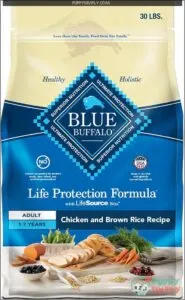
Curious about what sets top dog food brands apart for your Labrashepherd? Blue Buffalo Chicken Brown Rice puts real chicken first, with a solid Ingredient Analysis that avoids corn, wheat, and common allergens.
Its LifeSource Bits boost immune health, while added glucosamine and Omega-3s support joints and coat—big wins for a dog diet.
Clear Feeding Guidelines help you avoid overfeeding, and the brand’s clean Recall History and thoughtful Health Additions make food consumption safer for your pup’s daily dog feeding and nutrition.
Best For: Adult dogs, especially medium and large breeds, who need high-quality, allergen-friendly food with joint and immune support.
- Real chicken is the first ingredient and there are no fillers, making it great for sensitive stomachs.
- Fortified with LifeSource Bits and added glucosamine for immune and joint health.
- No corn, wheat, soy, or by-products; supports healthy skin and coat with essential fatty acids.
- Higher price point compared to many other kibble brands.
- Kibble size may be too large for small dogs or picky eaters.
- Not suitable for dogs with specific dietary restrictions or protein allergies.
2. Diamond Naturals Beef and Rice
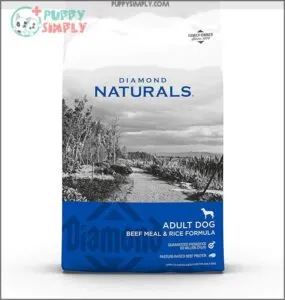
Picture your dog diving into Diamond Naturals Beef and Rice—a dog food that makes beef protein the star. This formula isn’t just about taste; it’s loaded with superfood benefits, like kale and pumpkin, supporting total health.
The guaranteed analysis gives you peace of mind, confirming quality protein and balanced nutrients. Probiotic strains help digestion and immune function, making transitions smoother.
Following their clear feeding guidelines, you can easily tailor portions, making this one of the best choices among dog food brands for smart feeding.
Best For: Owners who want a high-quality, nutrient-rich kibble that promotes strong muscles, healthy digestion, and a shiny coat for their adult dog.
- Real pasture-raised beef as the first ingredient for lean muscle support.
- Packed with superfoods, probiotics, and omega fatty acids for full-body health.
- Made in the USA with strict quality and safety controls.
- Transition period may cause gas or digestive upset for some dogs.
- Higher price tag, especially for households with large or multiple dogs.
- Not suitable for dogs with beef allergies or some food sensitivities.
3. Nutro Ultra Senior Dog Food

Senior ingredients matter when your German Shepherd Lab mix starts to slow down. Nutro Ultra Senior Dog Food aids joint support, thanks to real chicken, lamb, and salmon, plus chondroitin and glucosamine.
Free from artificial fillers or byproducts, its guaranteed analysis aids your dog’s aging body without compromise. The recall history is reassuring—no senior formula recalls.
Feeding guidelines are straightforward, making it a smart pick for German Shepherd Lab Mix food requirements focused on real dog health and practical, balanced nutrition.
Best For: Senior dogs, especially larger breeds like German Shepherd Lab mixes, needing balanced nutrition and extra joint support.
- Premium proteins from real chicken, lamb, and salmon boost strength and muscle maintenance.
- Packed with antioxidants and omega fatty acids for healthy skin, coat, and immune system.
- No artificial fillers or byproducts, and has a strong safety record with no senior formula recalls.
- Pricey at over $80 per bag, which may be a barrier for some.
- Dogs with sensitivities to specific animal proteins or grains might not tolerate it well.
- May cause digestive upset if switched too quickly from a different food.
4. Arm Hammer Dental Chew Toy
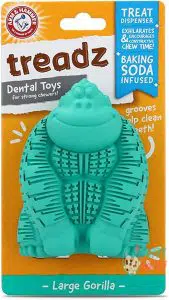
A tough-as-nails dog toy can be a lifesaver for dental hygiene and chewing behavior, especially with a German Shepherd Lab mix’s active jaw. Arm & Hammer’s Dental Chew Toy blends material durability—natural rubber, no stuffing—for toy safety and long-lasting use.
Tire-like ridges help reduce tartar and plaque, promoting dog dental health with every chomp. With a spot to insert treats, you get built-in motivation, too.
This is smart dog care that aids pet health and keeps playtime both safe and satisfying.
Best For: Active dogs like German Shepherd-Lab mixes who need durable, dental-friendly chew toys for healthy mouths and focused play.
- Helps keep teeth clean with natural rubber and Arm & Hammer baking soda.
- Withstands chewing from strong jaws and aggressive chewers.
- Treat-hiding feature adds extra motivation and fun.
- Must be used with supervision; not for eating or swallowing.
- Strong rubber smell may bother some dogs or people.
- Some dogs might lose interest if there are no treats inside.
5. FURminator Large Long Hair Dog Tool

If your couch looks like it’s growing fur, it’s time for real de-shedding benefits. The FURminator Large Long Hair Dog Tool makes dog coat care feel less like a battle and more like a routine.
Designed for proper technique and breed suitability, this tool cuts dog shedding by up to 90%. Tool maintenance is simple, thanks to the FURejector button and protective edge guard.
For about $45–$50, this grooming staple addresses your dog’s coat—and your home’s sanity—without constant visits to a groomer.
Best For: Large dogs with long hair (over 50 lbs, over 2-inch coat) whose owners want to cut down on shedding at home.
- Dramatically reduces loose fur and shedding around the house
- Stainless steel deShedding edge reaches deep without hurting your dog
- Easy to clean with a push-button hair release
- Not safe for dogs with very short or non-shedding coats
- Loose hair may fly around if not used carefully
- Requires the right brushing technique to avoid discomfort
Frequently Asked Questions (FAQs)
What is the average lifespan of a German Sheprador?
Think of your dog’s life like a tapestry—each thread shaped by Genetics, Care Impact, and Breed Variations.
Most German Shepradors live 10–12 years, though health issues can shorten—or, with luck and love, sometimes lengthen—that journey.
Are German Shepradors good with children and other pets?
Child safety is top of mind, and temperament testing helps. With early socialization and supervised play, a German Shepherd Lab Mix shines as a family pet.
Breed prejudice aside, they usually enjoy dog play and show strong pet compatibility.
How do you find a reputable German Sheprador breeder?
Ask about breeder experience, demand health guarantees, and look for clear genetic testing.
Visit the facility to check conditions and temperament assessment.
Seek breeders with a trusted reputation, registration, and a focus on German Shepherd Lab Mix breed information.
What types of foods and diet are ideal for a German Sheprador?
Go for high-quality dog food with lean protein sources and moderate fat. Portion control matters, especially as your Sheprador grows.
Puppy diets differ from senior nutrition needs—watch for allergies and adapt dog feeding and nutrition as needed.
Are Shepradors suitable for first-time dog owners?
Juggling a tornado while learning to juggle sums up getting a Sheprador as your first dog. Owner experience needed is high—this breed’s complexity and dog training commitment make alternative breeds better fits for easygoing, first-time dog care.
Can Labrashepherds adapt to apartment living?
Labrashepherds aren’t always the best fit for tight apartments, thanks to their high energy levels and dog activity needs. Without daily exercise alternatives and regular potty breaks, noise levels and social isolation can quickly become issues in small spaces.
What activities do Shepradors enjoy most?
If you want to see a Sheprador light up, offer agility training courses, scent work, hiking adventures, or water sports.
These dogs thrive with interactive games—physical exercise and mental stimulation together make dog play truly rewarding.
How do Shepradors react to hot or cold weather?
Extreme temperatures can be tricky for your German Shepherd Lab Mix. Their double coat offers good insulation, but paws need protection from hot or icy ground, and hydration needs jump in heat. Mind breed sensitivity—adjust dog exercise and grooming accordingly.
Conclusion
With a Labrashepherd, you’re barking up the right tree. This German Shepherd Labrador mix isn’t just a list of tips, but a window into a dog that wears a shepherd’s badge and a Lab’s sunshine smile.
Living with one? Expect loyalty, cleverness, and a dash of delightful unpredictability. If you offer love, structure, and a place for zoomies, you’ll find more than a pet—you’ll have an adventure buddy for life.

